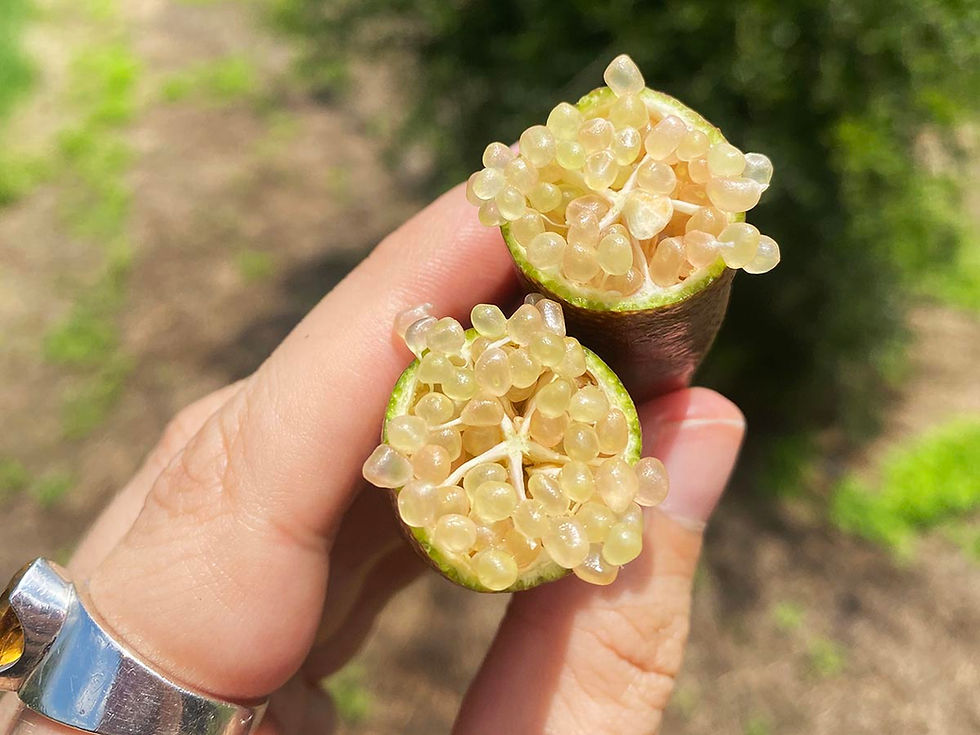Why this is the most unique gin you should have in your bar
- Jimmy & Christina Butcher - Mr & Mrs Romance
- Jan 24, 2022
- 3 min read
Lots of Aussie gins have finger lime in them. Some even have the caviar from the fruit in them. But Wild Hibiscus Distilling Co’s finger lime gins take it a few steps further than anyone.
If you’re not sure what a finger lime is, what it looks like or where it comes from, let me explain.
Finger limes are a native Australian fruit that look a bit like a knobbly green finger, hence the name.
When you split open its thick, tough skin, you find hundreds of tiny translucent balls that look like green (or sometimes red) salmon caviar. Each of these little balls is full of delicious lime-flavoured juice.

Where do finger limes grow?
We were lucky enough to meet with Wild Hibiscus Distilling Co owner and creator of this gin Lee Etherington at his farm in the Blue Mountains, surprisingly close to Sydney.
Lee showed us the finger lime groves and explained the difficult harvesting process. It’s not as simple as plucking these strange fruit from the trees and popping them in the gin still.
First of all, the trees are armed with giant thorns and the fruit has to be hand-picked. Second, the skins can release a thick oil, which not only sticks to skin and clothing, but also can give the gin a very bitter taint.

Thirdly, the fruit is also full of little seeds that need to be carefully removed. Fourthly, they grow all year round, so harvesting has to take place reactively as the fruit ripens on each tree.
Fourthly, Lee explained that the thousands of little holes in the ground around the finger lime orchard were in fact trapdoor and funnel web spider burrows!
But the effort and peril is all worth it.

How Wild Hibiscus Distilling Company’s Finger Lime Gin is made
Simply to look at, this Finger Lime Gin is quite extraordinary. Aside from the beautiful metal label and unusual bottle shape, the gin has finger lime caviar in seeming suspended animation floating throughout the gin.
As Lee explained, there are a few gins out there that have finger lime caviar in them, but when you put the fruit in the gin, it just sinks to the bottom and sits there. Not attractive and also hard to get at if you want to taste the finger lime caviar.
So began an R&D project that would take Lee over 10 years to find a solution.
Lee wanted to create a way that would make the finger lime caviar ‘float’ throughout the gin. Not only because it looks cool, but also because he wanted a way for people to have finger lime caviar in every sip not just all at the end.

Using a trade secret technique, Lee found a way to manipulate a certain protein from a lotus plant to create an invisible, odourless, flavourless web inside the gin that holds each little finger lime berry within its network.
Lee also decided that maximising the sensation of the finger limes in the gin and balancing the flavours meant he needed to create one more step.
He made an entirely new gin to infuse the finger lime caviar in.
So not only are you getting the gin the ginger limes are floating in, you get an entirely different gin inside the berries too.
Wild Hibiscus Distilling Co’s Deep Dark Red Finger Lime Gin
As you've probably noticed, Lee Etherington doesn’t see the world the same way most of us do.
And because he can’t stop himself, Lee has created yet another challenge with this intensely coloured gin.
There are no artificial colours here. Instead, Lee uses hibiscus flowers from his farms in Thailand.

These flowers were the beginning of his journey into creating amazing drinks - Lee invented the hibiscus flower in syrup garnish you’ve probably seen.
Pairing this coloured gin with a red finger lime and using the same technology to suspend the caviar in the gin, Lee has created something quite remarkable.
On its own, the Deep Red Finger Lime Gin has quite a medicinal taste from the ginger and lime leaf, but adding ginger beer to it brings this drink alive.
Yes, this is an expensive gin - not the most expensive, but it’s up there. But considering the decade of development and creativity invested, and the startling beauty of the gin, it’s actually pretty good value.
Plus, these gins are made to be mixed, so one bottle goes quite a long way!


Comments